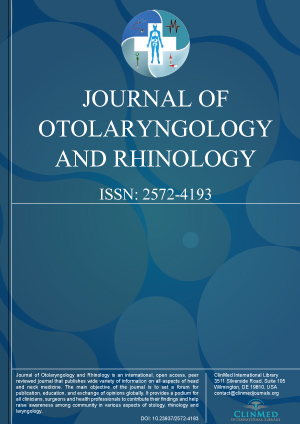Open Access DOI:10.23937/2572-4193.1510073
Secondary Rhinoplasty Using Autologous Rib Cartilage: A Review
Guillermo Navarro Santos, Sylvia Elizabeth Villarreal Navarro, Arturo Alanís Ibarra, Sergio Andrés de Lara Ovalle, Adriana Miroslava Pérez Peña and Esaú Floriano Sánchez
Article Type: REVIEW Article | First Published: March 16, 2020
Rhinoplasty is one of the most complex procedures in the cosmetic surgery field. Satisfactory long-term results rely on using grafts with enough strength for adequate support and low resorption rates. Grafts in septorhinoplasty can be obtained from autologous, homologous and alloplastic materials. Autologous rib cartilage is the graft material of choice for secondary rhinoplasty when enough septal cartilage is not available....
Open Access DOI:10.23937/2572-4193.1510072
Primary Thyroid Lymphomas: A Report of Five Cases
Hajar Haoufadi, Mohamed Chehbouni, Youssef Rochdi, Hassan Nouri and Abdelaziz Raji
Article Type: Case Series | First Published: February 12, 2020
Primary thyroid gland lymphoma is a rare condition, accounting for only 2% of extranodal lymphomas, usually occurring in patients with autoimmune thyroiditis. Among these lymphomas, B-cell non-Hodgkin lymphoma is the most frequently encountered, while Hodgkin’s disease and T-cell lymphomas are extremely rare. Through this paper, we report 5 primary thyroid lymphoma cases, diagnosed in our department in a period of 6 years (Jan 2012 to Dec 2017), all of them were B-cell Non-Hodgkin Lymphomas. P...
Open Access DOI:10.23937/2572-4193.1510071
Patient Reported Outcomes of Balloon Dilation for Eustachian Tube Dysfunction Using the SNOT-22 Survey
Zahrah M Taufique, MD, MBA, Steven A Gordon, MD, MPH, Janine M Rotsides, MD, Jamie R Oliver, BA and Lisa A Liberatore, MD
Article Type: Original Resear ch | First Published: January 15, 2020
Eustachian tube dysfunction is a common medical condition affecting approximately 1% of the adult population. Previous studies have evaluated eustachian balloon tuboplasty using tympanometry, ability to perform Valsalva maneuver and subjective improvement in symptoms to measure effectiveness. In this study, we propose using the Sino-Nasal Outcome Test (SNOT-22) to measure outcomes following eustachian tube balloon dilation, with a focus on ear-specific symptoms within the survey....

